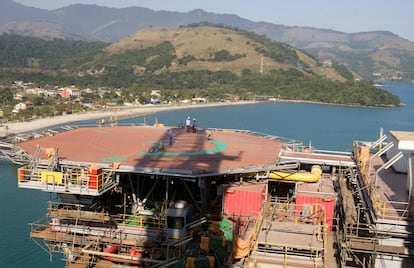Increased supply and weak demand flood the oil market
According to the International Energy Agency, fragile growth, efficiency and electrification are key factors. OPEC+ is also losing its market share with greater supply from the United States, Brazil, Guyana and Canada

The signs of market flooding are piling up. While still increasing, global oil demand is slowing down: according to the International Energy Agency’s (IEA) latest projections, this year’s increase will be 1.2 million barrels per day, half of what it was in 2023 (2.3 million). A combination of factors are behind this slowdown: moderate economic growth, greater efficiency in consumption and an increasingly notable boom in electric vehicles — and battery-powered mobility in general — which is beginning to take the most polluting cars and motorcycles off the road.
There’s also another market force that will contribute to further widening a gap that has become crude oil producers’ main concern and is clearly exerting downward pressure on prices. Supply from four Western hemisphere countries — the United States, Brazil, Guyana and Canada — will increase by 1.5 million barrels per day in 2024. Of the four, the only OPEC+ member is Brazil, which just announced its membership. Under the leadership of Saudi Arabia and Russia, OPEC+ has been trying to cut supply to correct the market imbalance for months. But they are not succeeding in that policy: the brent price (the European market benchmark) is now below $80, compared to nearly $100 at the end of the summer.
Risk in the Middle East
Despite these underlying dynamics, which will be exacerbated in the coming years as electrification and sustainable fuels gain traction in transportation, the IEA warns of the risk of rising geopolitical tensions in the Middle East, which have markets “on edge” at the beginning of 2024.
“The US-UK air offensive against Houthi targets in Yemen, in response to the Iranian-backed group’s attacks on oil tankers in the Red Sea, raises concerns about an escalation of the conflict that could further disrupt the flow of oil,” the Paris-based agency’s technicians write. “Although oil and liquefied natural gas (LNG) production has not been affected, a growing number of ship owners are diverting cargo that previously passed through the Red Sea.”
One fact says it all: almost 10% of the oil and 8% of the gas that moves by ship around the world passes — or used to pass — through the area. On Monday, Qatar, the world’s second largest exporter of liquefied natural gas, announced that its LNG carriers will abandon that route for a longer one through the Cape of Good Hope (South Africa), which adds almost two weeks of sailing and substantially increases the cost of transportation.
Still, the IEA believes that the market will be “reasonably well supplied” in 2024. That is largely because of “higher-than-expected” production in non-OPEC+ countries, which will trump the cartel’s cuts and allow new supply to “outstrip demand growth by a wide margin.”
More Russian export
After a relatively effective first few months, recently Western sanctions on Russian oil have ceased to bear fruit. Instead of slackening, crude exports from the Eurasian giant grew by 500,000 barrels per day in December, reaching a new world high of 7.8 million barrels per day on monthly pumpings of nearly 9.5, the OECD’s energy department says. These figures make Russia the world’s second largest oil producer, behind only the United States and clearly ahead of Saudi Arabia, the traditional leader.
With these numbers in hand, the IEA calculates that Moscow’s oil revenues amounted to $14.4 billion in December. That’s a substantial figure, but it is lower than in previous months because Russia was forced to offer higher discounts in order to be able to sell its crude — which has become toxic in much of the world because of its invasion of Ukraine — and especially because of the generalized decline in oil prices.
Sign up for our weekly newsletter to get more English-language news coverage from EL PAÍS USA Edition
Tu suscripción se está usando en otro dispositivo
¿Quieres añadir otro usuario a tu suscripción?
Si continúas leyendo en este dispositivo, no se podrá leer en el otro.
FlechaTu suscripción se está usando en otro dispositivo y solo puedes acceder a EL PAÍS desde un dispositivo a la vez.
Si quieres compartir tu cuenta, cambia tu suscripción a la modalidad Premium, así podrás añadir otro usuario. Cada uno accederá con su propia cuenta de email, lo que os permitirá personalizar vuestra experiencia en EL PAÍS.
¿Tienes una suscripción de empresa? Accede aquí para contratar más cuentas.
En el caso de no saber quién está usando tu cuenta, te recomendamos cambiar tu contraseña aquí.
Si decides continuar compartiendo tu cuenta, este mensaje se mostrará en tu dispositivo y en el de la otra persona que está usando tu cuenta de forma indefinida, afectando a tu experiencia de lectura. Puedes consultar aquí los términos y condiciones de la suscripción digital.
More information
Últimas noticias
Venezuelans in exile: ‘This could be the end of a very dark chapter for Venezuela, but also the beginning of a time of uncertainty’
Key points of the military attack on Venezuela: Early morning bombings and a ‘captured’ president
World reactions to the US strikes on Venezuela
Nicolás Maduro, the autocrat of an isolated Venezuela who had no intention of surrendering
Most viewed
- Alain Aspect, Nobel laureate in physics: ‘Einstein was so smart that he would have had to recognize quantum entanglement’
- David King, chemist: ‘There are scientists studying how to cool the planet; nobody should stop these experiments from happening’
- Mexico completes its trade shift with the entry into force of tariffs on China and countries without trade agreements
- Reinhard Genzel, Nobel laureate in physics: ‘One-minute videos will never give you the truth’
- Oona Chaplin: ‘I told James Cameron that I was living in a treehouse and starting a permaculture project with a friend’











































